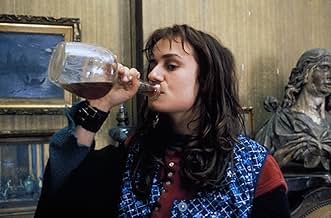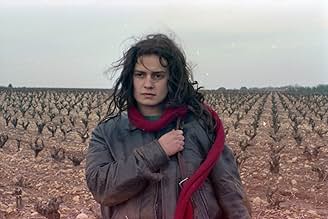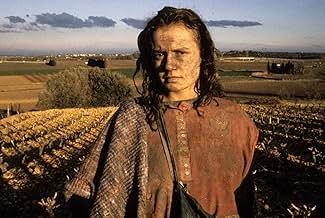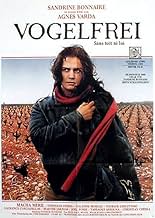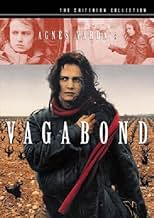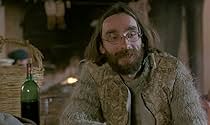CALIFICACIÓN DE IMDb
7.6/10
15 k
TU CALIFICACIÓN
El cuerpo de una joven es encontrado, congelado, es una zanja. A través de flashbacks y entrevistas, descubrimos las circunstancias que condujeron a su muerte.El cuerpo de una joven es encontrado, congelado, es una zanja. A través de flashbacks y entrevistas, descubrimos las circunstancias que condujeron a su muerte.El cuerpo de una joven es encontrado, congelado, es una zanja. A través de flashbacks y entrevistas, descubrimos las circunstancias que condujeron a su muerte.
- Dirección
- Guionista
- Elenco
- Premios
- 8 premios ganados y 5 nominaciones en total
- Dirección
- Guionista
- Todo el elenco y el equipo
- Producción, taquilla y más en IMDbPro
Opiniones destacadas
We know from the very beginning the fate of Sandrine Bonnaire's Mona, the "Vagabond" of the title in Agnes Varda's magnificent film. She's dead, a frozen corpse in a ditch and then, in flashbacks, we see how she got there. Varda never passes judgment and "Vagabond", like her very best films, is a work of observation. As well as a handful of professional actors she uses the people of the towns and villages Bonnaire passes through, giving the film an air of reality while Bonnaire herself is simply superb.
Varda doesn't require her to do anything but exist and it's a very 'un-actressy' performance, closer to real life than to what we are used to seeing in the movies. Now and again the film dips into the conventional as if Varda is trying to put some meat on its bones but for the most part, this is a remarkable work and one of the best of its director's career.
Varda doesn't require her to do anything but exist and it's a very 'un-actressy' performance, closer to real life than to what we are used to seeing in the movies. Now and again the film dips into the conventional as if Varda is trying to put some meat on its bones but for the most part, this is a remarkable work and one of the best of its director's career.
Agnès Varda is commonly associated with the Nouvelle Vague and more than François Truffaut, Jean-Luc "God Ard" or Eric Rohmer, she delivered some of the jewels of this French trend with "Cléo De 5 à 7" (1961). It doesn't mean that everything she made turned into gold. One can skip "les Créatures" (1966) without remorse. Twenty years later, she issued her strongest work since "Cléo De 5 à 7" which justifiably dominated from an artistic perspective French cinematographic production: "Sans Toi Ni Loi" that caused a stir.
It works as an alternation of flashes-back and interviews with people about their recollections involving a female rambler named Mona. We won't know much about herself. After she passed her high school diploma, she started to work for different bosses as a secretary but grew tired of his job. So, she packed in to leave for adventure through odd jobs. However, Varda's heroine keeps all her mystery and ambiguity. Are we really sure about what she says? Doesn't she lie? The female filmmaker doesn't comfort the audience because as the elements of the puzzle are pieced together, she throws the people who met Mona out in the same basket, either it is this university professor, this Maroccan guest worker or this former philosophy student who believed in the events of May 1968 in France: they are all responsible for Mona's death because of their egoism, their lack of communication with her. Varda delivers a similar message to her 1961 film: loneliness is a burden and it's better to open oneself to others to make things improve.
"Sans Toi Ni Loi" has the form of a documentary with a gritty tonality in which the female filmmaker keeps a certain distance with her heroine and everything she goes through. Thanks to this, tawdry or violent sequences take another dimension like the moment when the garage owner leaves Mona's tent pulling up his trousers or the man who rapes her in the woods. We won't see the horrid act.
Varda hired non-professional actors and that's why her film has a larger than life feel. An impression accentuated by Sandrine Bonnaire's sensational performance. She "lives" more than she acts her role. The role of this rambler fits her like a glove.
This is one that can stand multiple viewings.
It works as an alternation of flashes-back and interviews with people about their recollections involving a female rambler named Mona. We won't know much about herself. After she passed her high school diploma, she started to work for different bosses as a secretary but grew tired of his job. So, she packed in to leave for adventure through odd jobs. However, Varda's heroine keeps all her mystery and ambiguity. Are we really sure about what she says? Doesn't she lie? The female filmmaker doesn't comfort the audience because as the elements of the puzzle are pieced together, she throws the people who met Mona out in the same basket, either it is this university professor, this Maroccan guest worker or this former philosophy student who believed in the events of May 1968 in France: they are all responsible for Mona's death because of their egoism, their lack of communication with her. Varda delivers a similar message to her 1961 film: loneliness is a burden and it's better to open oneself to others to make things improve.
"Sans Toi Ni Loi" has the form of a documentary with a gritty tonality in which the female filmmaker keeps a certain distance with her heroine and everything she goes through. Thanks to this, tawdry or violent sequences take another dimension like the moment when the garage owner leaves Mona's tent pulling up his trousers or the man who rapes her in the woods. We won't see the horrid act.
Varda hired non-professional actors and that's why her film has a larger than life feel. An impression accentuated by Sandrine Bonnaire's sensational performance. She "lives" more than she acts her role. The role of this rambler fits her like a glove.
This is one that can stand multiple viewings.
10nbott
There are many different reasons to watch a film. I personally enjoy casual get out the six pack of beer type movies and I appreciate sincere great film art. Vagabond is one of the greatest films I have ever seen. I was drawn into this deeply tragic tale from the very opening scene with the wonderful music and cinematography. The documentary style used as a device to tell the story of Mona was bold and very appropriate to convey the depth of the impact this person had on the other characters in the film.
The acting of Ms. Bonnaire convinced me to care about this deeply troubled character and the isolated existential life she led. I personally have met in my own life people living in this way and I am always perplexed that I can not understand what is going on in that person's head. This film is and example of what makes great art. It tells a story that is universal and yet very personal. See this film. (10 out of 10).
The acting of Ms. Bonnaire convinced me to care about this deeply troubled character and the isolated existential life she led. I personally have met in my own life people living in this way and I am always perplexed that I can not understand what is going on in that person's head. This film is and example of what makes great art. It tells a story that is universal and yet very personal. See this film. (10 out of 10).
With an antagonizing protagonist who is as doomed as the plane trees in the film...this film could be seen as strictly nihilistic. I recently watched "SherryBaby" and strongly preferred this film which I watched a week prior, and yet I still find myself pondering Sandrine Bonnaire's portrayal of a woman who is stranded.
Indeed "No one makes it alone" could better be the tag line here, and Bonnaire's Mona goes on an odyssey that is nothing short of harrowing. Also trading heroin chic for (self-imposed?) homeless bleak pushed us into less charted filmic waters. Choosing an unknown for the title role was also a good call I suspect. The film is now older than it's lead actress was at the time.
So much of the film talks about how Mona stinks, perhaps smell-a-vision would have helped ;> Honestly her face is still too attractive, although wide and maybe manly in a way, that for me the sense of her scent didn't wash. That being said, her disaffection was on display so well, that you could see her as having a dirty soul. At nearly every chance of being likable she veers to the other direction, the one notable exception for me being her interaction with the "platonologne" (is that like octogenarian, don't know the French...the characters all had interesting descriptions in the credits)..
Additionally, from the English subtitles and snatches of French, I sense the dialog (should I say dialogue) in this was quite cutting and clever in parts.
While Mona lives without roof or law, while she may move without purpose or direction, she is more than a human tumbleweed. She does not live without leaving a trace...but the filmmaker keeps us intentionally distant from her, we are never allowed inside her mental tent. Thus our composite sketch of her is as complex and contradictory as the people she encounters. Not only does Mona live without control over her life, her death as well eludes her.
Viewers may find it less easy to escape.
Thurston Hunger 7/10
Indeed "No one makes it alone" could better be the tag line here, and Bonnaire's Mona goes on an odyssey that is nothing short of harrowing. Also trading heroin chic for (self-imposed?) homeless bleak pushed us into less charted filmic waters. Choosing an unknown for the title role was also a good call I suspect. The film is now older than it's lead actress was at the time.
So much of the film talks about how Mona stinks, perhaps smell-a-vision would have helped ;> Honestly her face is still too attractive, although wide and maybe manly in a way, that for me the sense of her scent didn't wash. That being said, her disaffection was on display so well, that you could see her as having a dirty soul. At nearly every chance of being likable she veers to the other direction, the one notable exception for me being her interaction with the "platonologne" (is that like octogenarian, don't know the French...the characters all had interesting descriptions in the credits)..
Additionally, from the English subtitles and snatches of French, I sense the dialog (should I say dialogue) in this was quite cutting and clever in parts.
While Mona lives without roof or law, while she may move without purpose or direction, she is more than a human tumbleweed. She does not live without leaving a trace...but the filmmaker keeps us intentionally distant from her, we are never allowed inside her mental tent. Thus our composite sketch of her is as complex and contradictory as the people she encounters. Not only does Mona live without control over her life, her death as well eludes her.
Viewers may find it less easy to escape.
Thurston Hunger 7/10
You're an outcast, left to fend all on your own, reasons unclear, and only you're the one who knows, wandering the barren lands, in a winter where cold's fanned, on occasion some small morsel might be thrown. The net, that's meant to catch your fall has failed, as you cascade along a lost and lonely trail, folks indifferent to your plight, you're frustrations causing flight, becoming cornered, without wind to catch your sail.
Through an outstanding performance from Sandrine Bonnaire, the late, great Agnès Varda leaves us under no illusion of the cause of a young woman's death during her winter of discontent.
Through an outstanding performance from Sandrine Bonnaire, the late, great Agnès Varda leaves us under no illusion of the cause of a young woman's death during her winter of discontent.
¿Sabías que…?
- TriviaThe episodes in which the main character is involved are each marked off by a tracking shot, 13 of them.
- ErroresIn the opening segment, Mona (Sandrine Bonnaire) is lying in a ditch in the vineyard. The character Mona is supposed to be dead, but if you look at the actress's neck you can clearly see a neck artery visibly pulsing.
- Citas
les Bergers: She blew in like the wind. No plans, no goals... No wishes, no wants... We suggested things to her. She didn't want to do a thing. Wandering? That's withering. By proving she's useless, she helps a system she rejects. It's not wandering, it's withering.
- ConexionesFeatured in Siskel & Ebert & the Movies: The Best Films of 1986 (1987)
- Bandas sonorasVariations sur la Vita
Composed and directed by Joanna Bruzdowicz
Selecciones populares
Inicia sesión para calificar y agrega a la lista de videos para obtener recomendaciones personalizadas
- How long is Vagabond?Con tecnología de Alexa
Detalles
- Fecha de lanzamiento
- Países de origen
- Sitio oficial
- Idiomas
- También se conoce como
- Vagabond
- Locaciones de filmación
- Nîmes, Gard, Francia(train station)
- Productoras
- Ver más créditos de la compañía en IMDbPro
Contribuir a esta página
Sugiere una edición o agrega el contenido que falta

Principales brechas de datos
By what name was Sin techo ni ley (1985) officially released in India in English?
Responda
![Ver Bande-annonce [OV]](https://m.media-amazon.com/images/M/MV5BYWE4N2ViZjQtYzgyNy00MDIxLTk0ZWUtNjE5MmJlMWU3OTQ0XkEyXkFqcGdeQXRyYW5zY29kZS13b3JrZmxvdw@@._V1_QL75_UX500_CR0)
